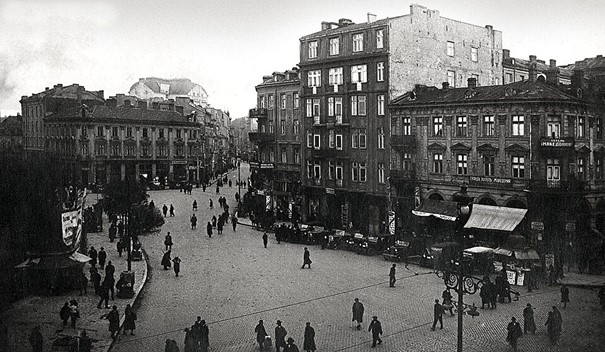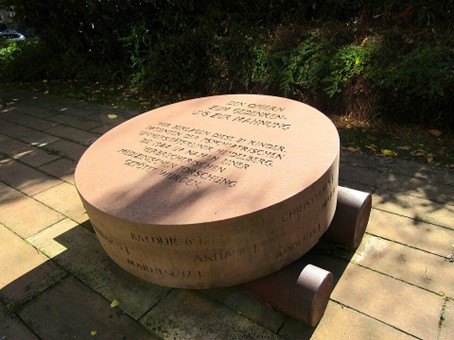Adolf Naudascher
born in 1931 in Sofia, Bulgaria
died in 1944 in Eichberg asylum, Eltville am Rhein, Germany
“One month before his death, I visited him once again. I will never forget this visit for the rest of my life. Dolfi was 13 years old at the time, I was 14. He was beaming with joy, and we competed in imagining how happy we would be once the war was over, and we were reunited with our parents. It was only when I had to tell him in the evening that I had to return to boarding school that he broke down: 'Take me with you! Take me with you! They are so mean to me here!'"
Fifty-four years after the death of his brother Adolf, known as Dolfi, Eduard Naudascher (1929–2012) recalled his visit to the psychiatric asylum Eichberg and spoke about it at a memorial event at the Psychiatric University Hospital in Heidelberg in 1998. The commemorative event, at which a memorial was unveiled, was dedicated to the underage victims of criminal research who were examined in the Heidelberg Hospital in 1943/44 and subsequently murdered at the Eichberg institution. Out of 52 children and adolescents examined, 21 were murdered, including the 13-year-old Adolf Naudascher in September 1944.

Adolf Naudascher was born in Sofia, Bulgaria. His father, civil engineer Eduard Naudascher (b. 1904), was the commercial director of Granitoid AG, an important company in the Bulgarian c onstruction industry founded by his uncle, who was also named Eduard Naudascher (1872–1945). In addition to his older brother Eduard, Adolf had two much younger siblings, a sister born in 1939 and a brother born in 1942.
According to his father’s report on June 13, 1944, in Heidelberg, Adolf Naudascher developed normally until about five months old, when he contracted meningitis. He had announced his visit by telegram, wanting to provide information in person. The boy then had suffered from tonsillitis accompanied by a high fever. They consulted Professor Franz Hamburger (1874–1954) at the Vienna Children’s University Hospital, where meningitis was diagnosed. Adolf Naudascher spent part of the following time with a foster mother in Mannheim, an acquaintance of his father, who had been born there. He also lived at times with the foster mother and his family in Sofia, returning permanently to Mannheim in 1942. There, he experienced the bombings, as his foster mother reported to the physician at the Heidelberg Psychiatric Hospital. On November 18, 1943, they were “bombed out.” Possibly in connection with this, Adolf Naudascher was placed in a protestant institution for children with intellectual disabilities in Northern Baden – the Erziehungs- und Pflegeanstalt für Geisteschwache (“Educational and Care Institution for the Mentally Feeble”) in Mosbach, founded in 1880. More specifically, he was admitted to the so-called Schwarzacher Hof branch for children considered incapable of education, which had been opened in 1936.
Along with other children, Adolf Naudascher was transferred from the Schwarzacher Hof to the Psychiatric University Hospital in Heidelberg on May 9, 1944. They were to be part of a research project led by Professor Carl Schneider (1891–1946), head of the psychiatric university hospital. Like the other children and adolescents included in the research program – 20 of whom came from Schwarzacher Hof – Adolf Naudascher stayed at the Heidelberg hospital for several weeks.iii There was no separate ward for Schneider's ″research children″; they were accommodated among adult patients. Adolf Naudascher was placed in the “Men's Garden House” of the hospital, where he stayed until June 26. This may have been because his father had announced his visit and asked for the child to be kept in Heidelberg until then. The other children transferred with him had already returned to Schwarzacher Hof after completing the extensive examinations typical of the research department.
Carl Schneider’s research department in Heidelberg was one of two such initiatives supported by the central “euthanasia” office at Tiergartenstraße 4 in Berlin. The other one was the research department of child psychiatrist Hans Heinze (1895–1983) at the Brandenburg-Görden institution. Both focused mainly on studying childhood so-called “feeblemindedness.”iv The Heidelberg department began its activities in 1943. Before, a research department had existed for a short time in the Wiesloch asylum near Heidelberg, but then had to close due to the war. The specific focus on children and adolescents diagnosed with so-called “exogenous or endogenous feeblemindedness” only began after transferring the research to Heidelberg. The goal was to correlate clinical findings in living children with post-mortem brain examinations to differentiate between inherited and acquired intellectual disabilities more accurately and to draw eugenic conclusions: families of children with acquired disabilities were to be encouraged to have more children, while families of children whose disability was considered hereditary were to be discouraged from doing so, with the possibility of involving the Hereditary Health Court (Erbgesundheitsgericht).
The extensive examination program at the Heidelberg Psychiatric Hospital was state-of-the-art at the time. It included physical examinations, psychiatric explorations, interviews with relatives, gathering of prior medical records and official correspondence, laboratory tests including metabolic studies, X-rays including painful pneumoencephalography (to assess the brain), anthropometric measurements, photography, occupational therapy, psychological testing, and the creation of a family genealogy (Sippentafel). The pre-printed content overview of the medical files shows that brain autopsy was part of the program – meaning the children's murder was planned from the beginning.
Adolf Naudascher underwent a comprehensive examination. Family information about his infantile meningitis and subsequent symptom development was confirmed through correspondence with the Vienna Children's Hospital. Therefore, his condition was considered an exogenously caused mental disability. Interviews suggested that the child learned to speak late and with difficulty. He had only brief private tutoring and could neither read nor write, though he could perform simple tasks. He was described as very musical and curious about his surroundings. Nursing reports characterized him positively as compliant, adaptable, and sociable. During testing, he made great efforts and was pleased when he succeeded. However, he refused the ″cold bath test″ after checking the water with his hand, pleading not to enter – no amount of coaxing persuaded him. Certain tests could not be completed due to a physical disability: one side of his body was described as weaker, impairing his mobility. Pneumoencephalography revealed a “hydrocephalus internus”, a significant enlargement of the brain ventricles, the cerebrospinal fluid spaces inside the brain. On June 9, 1944, during a presentation in the Psychiatric University Hospital's lecture hall, Professor Schneider diagnosed a “condition following encephalitis, Little's disease, athetosis, and feeblemindedness” – movement disorders caused by early brain impairment and intellectual disability.
During his time at the Heidelberg clinic, Adolf Naudascher sometimes cried. When asked why, he responded, “I’m homesick.” He evidently missed his family, his foster mother, or at least the other children at Schwarzacher Hof. He was transferred back there on June 26, 1944, but only for a short time. On July 28, 1944, he was sent to the Eichberg psychiatric asylum in Hesse, a facility that Carl Schneider collaborated with. Eichberg hosted one of about 30 Kinderfachabteilungen (“children’s special wards”) set up for “child euthanasia.” Here, the Heidelberg “research children” were to be murdered, with their brains sent back to Heidelberg for examination.
Adolf Naudascher lived at Eichberg for seven weeks. His brother Eduard’s remembered visit must have occurred during this period. Adolf Naudascher died on September 9, 1944. A list of brains sent to Heidelberg during the Nazi era includes his name.

After Adolf Naudascher’s death, Dr. Dr. Julius Deussen (1906–1974), who coordinated Carl Schneider’s research program at the Heidelberg hospital, continued corresponding with Adolf’s father, Eduard Naudascher. The tone between the physician and the entrepreneur was friendly. The two had met during Eduard’s visit in June 1944, when the medical history was taken – and apparently, “euthanasia” was also discussed. Deussen had noted by hand that the father "could not consent to euthanasia." In the letters following the boy’s murder, Deussen expressed concern for the family's situation given the war developments in Sofia (Bulgaria was occupied by Soviet forces on September 8–9, 1944). However, he also wrote to request additional photographs needed to complete Adolf Naudascher’s medical file.
In late October 1944, Adolf Naudascher’s father reported that the family had managed to reach Austria under adventurous circumstances. There, he received “the painful news of our beloved little Dolfi's death” too late to attend the funeral. He found some comfort in the thought that the boy had been “released from his severe, incurable suffering.” In November 1944, he inquired more specifically about the circumstances of his son’s death: “Was he ill for a long time? How were his final hours? Did he feel very lonely?”
Deussen claimed he would first inquire at Eichberg but already pretended that the boy had not been ill for long and “would not have felt lonelier than before, since, as I know personally, the treatment and accommodations there were good and the surroundings beautiful.” In a postscript, he added: “According to information from Eichberg, Dolfi died of pneumonia, without suffering.”
The correspondence ends there – no photographs requested by Deussen are found in Adolf Naudascher’s medical records.
This biography was written by Maike Rotzoll.
© 2025 by Maike Rotzoll, licensed under
CC BY 4.0


Sources:
All information regarding Adolf Naudascher’s biography is taken from the Heidelberg medical records, archived under reference F 38 in the collection of the ″Forschungskinderakten″ ("Research Children's Files") at the Historical Archive of the Clinic for General Psychiatry. All quotations also originate from documents contained in this file.
Literature:
Eduard Naudascher, Worte eines betroffenen Angehörigen, in: Christoph Mundt, Gerrit Hohendorf, Maike Rotzoll (eds.): Psychiatrische Forschung und NS-„Euthanasie“. Beiträge zu einer Gedenkveranstaltung an der Psychiatrischen Klinik Heidelberg, Heidelberg 2001, p. 33-39, here p. 33.
Hans-Werner Scheuing, „…als Menschenleben gegen Sachwerte gewogen wurden“. Die Geschichte der Erziehungs- und Pflegeanstalt für Geistesschwache Mosbach/Schwarzacher Hof und ihrer Bewohner 1933-1945, second edition, Heidelberg 2004 (first edition 1997), p. 371-401.
For Carl Schneider's Heidelberg research department, see, among others:
Roelcke, Volker / Hohendorf, Gerrit / Rotzoll, Maike, Psychiatric research and ‘euthanasia‘. The case of the psychiatric department at the University of Heidelberg, 1941 – 1945, History of Psychiatry 5 (1994), p. 517-532;
Hohendorf, Gerrit / Roelcke, Volker / Rotzoll, Maike, Innovation und Vernichtung – Psychiatrische Forschung und „Euthanasie” an der Heidelberger Psychiatrischen Klinik 1939–1945, in: Der Nervenarzt 67 (1996), p. 935-946;
Rotzoll, Maike / Hohendorf, Gerrit, Murdering the sick in the name of progress? The Heidelberg Psychiatrist Carl Schneider as a brain researcher and “therapeutic idealist”, in: Weindling, Paul (ed.): From Clinic to Concentration Camp, London 2017, p. 163-182.
